Growing Echeveria plants is simple, but they do require some basic care to look their best.
The Echeveria ‘Black Knight’ plant is no exception.
This variety is one of the most popular of all the Echeveria species. It features a stunning deep maroon color and interesting formation.
This article will provide you with everything you need to know about caring for, growing, and propagating this succulent plant species.
Overview
Echeveria ‘Black Knight’ is a succulent flowering plant from the Crassulaceae family native to Mexico and Central America.
The Black Knight Echeveria is a slow-growing succulent with pointed, black rosettes of fleshy leaves.
The deep green center in the middle of Black Knight rosettes stands out against the dark outer leaves.
This Echeveria species may reach a height of up to 15 cm (6′) and a diameter of about 21 cm (8′).
Black Knight succulents produce bright red flowers on arching, slender stalks in late summer and fall.
How To Care for Echeveria ‘Black Knight’
Taking care of Echeveria plants is simple and yields a stunning succulent, suitable for placement in nearly any location.
Below you’ll find the most important information you need to know about caring for Echeveria Black Knight.
Sun Exposure & Light Requirements
Echeveria ‘Black Knight’ plant thrives in full sun to partial shade.
The more sun it gets, the more color it will have. It can take full sun for a few hours each day or all day in indirect bright light.
When grown indoors, it likes to be in a west or east-facing window, where it gets some morning light, and some more afternoon/evening light but where there is some shade during the middle of the day.
Echeveria ‘Black Knight’ will turn a lighter green color when it is in bright light; the more sun it gets, the darker and glossier its leaves will be.
Watering Requirements
Echeveria ‘Black Knight’ succulent plants are known to survive long periods of drought. For this reason, they are not accustomed to frequent watering.
It is best to water them at least once per week during the summer season, only if the plant is exposed to full sunlight all day or if it’s located in a hot area.
If your Echeveria is kept in the shade, it does not require watering more than once every two weeks.
As a general rule, it is best to water your Echeveria plants thoroughly and then let them dry out before watering again.
When watering your Echeveria, it’s best to water the soil, not the plant. Use a watering can with a rose attachment to avoid getting any spills on the leaves.
The best time to water your succulent is in the early morning or late evening when temperatures are lower and the dew has had time to dry off.
Additionally, the excessive watering of your succulent can lead to the development of root rot (fungal infections) and kill the plant faster than under-watering.
Soil Requirements
Echeveria ‘Black Knight’ grows best in loose, well-drained soil. The plant will not grow well if the soil is too dense and compact.
To achieve the greatest success in caring for this variety, use a cactus or succulents soil mix.
The best part about using a succulents-only soil is that it helps prevent root rot, the most common cause of death for indoor plants.
Add some coarse sand and perlite to regular potting soil if you want to mix your soil. This will ensure that the soil drains well.
Temperature and Humidity
Echeveria ‘Black Knight’ plants require a minimum temperature of 50 °F or 10 °C to survive, with a maximum optimal temperature of 82.4 °F or 28.0 °C.
The Echeveria generally prefer moderate temperatures and shouldn’t be exposed to extreme heat.
Try to keep the temperature around 68° – 80° Fahrenheit (20 – 27°C) during the day, with nighttime temperatures between 50° – 70° Fahrenheit (10 – 21°C).
Humidity is another aspect to consider. Echeveria succulents grow well in dry environments and need to be watered accordingly.
Try to maintain humidity levels around 40% and provide good ventilation if the humidity is very high.
Fertilizing
Echeveria ‘Black Knight’ is a succulent plant that is typically grown in containers.
For this reason, a balanced liquid fertilizer diluted to half-strength (feeds the soil, not the leaves) should be given during the growing season.
Once flowering has occurred, it’s best to stop fertilizing that plant; since growth slows down anyway, there is no need to feed it anymore.
On the other hand, fertilizing is not necessary if you are growing this plant in the ground.
With that said, remember that too much fertilizer does more harm than good.
The standard indoor-plant fertilizer sold in most stores contains much more powerful nutrients than plants need to survive or thrive.
Potting and Repotting
Echeveria ‘Black Knight’ is a slow-growing succulent. It should be repotted every other year in spring or autumn.
It only needs to be repotted when the soil is getting too old or the plant is getting too big for the pot, usually after two years.
Make sure you have a container with drainage holes. Use a container that has enough room for your succulents to grow without being buried under the soil.
Ensure the container has good drainage by placing gravel or broken pots at the bottom to help water flow.
It is best to use terracotta or unglazed pots because they allow the soil to dry out faster and will not retain too much moisture.
Pruning
Echeveria ‘Black Knight’ is an easy succulent plant to care for.
Regarding pruning, Echeveria ‘Black Knight’ doesn’t need much attention.
The only pruning Echeveria ‘Black Knight’ needs is the removal of dead leaves and flowers. This is because the dead parts will lead to bacterial and fungal infections.
Echeveria ‘Black Knight’ is a non-invasive plant, so you don’t have to worry about it spreading.
If Echeveria ‘Black Knight’ begins to spread too much and covers up other succulents around it, repot the succulent plant in a smaller pot or move it to a different area of your garden.
Pests and Diseases
Echeveria ‘Black Knight’ is susceptible to pests and diseases like other Echeveria or succulent plants.
These include:
Mealybugs
Mealybugs will appear as small cottony masses on the stems and leaves of succulent plants.
They are soft to the touch, slow-moving, white in color, and tend to feed on plant juices.
The easiest way to destroy mealybugs is by dabbing them with cotton swabs dipped in alcohol.
Scale insects
Scale insects are small, immobile insects that appear hard and shaped like shells.
They feed on the juices of succulent plants, making them look unthrifty or even diseased.
The easiest way to get rid of scale insects is to dab them with cotton swabs dipped in alcohol.
Aphids
Aphids are small, soft-bodied insects that can move quickly from one plant to another.
They tend to feed on the juices of succulent plants, causing them to look pale or sickly.
Aphids can be removed by hand or with a strong stream of water.
If you choose the second option, wash the leaves and stems of the plant you’re treating with a mild soap solution to remove any remaining aphids.
Spider mites
Spider mites are small, eight-legged creatures that spin webs in succulent plants and feed on their juices.
They will look like smudges or dusty patches in the leaves and stems of your succulents.
They can be removed by hand and treated with a mild soap solution.
Root Rot
Root rot is a result of overwatering Echeveria ‘Black Knight’.
It will cause your succulent roots to turn black and shrivel, which may cause the entire plant to rot.
If you suspect your succulent is suffering from root rot, remove it from its pot and carefully inspect the roots.
If they are blackened, remove any dead roots and immediately reduce the water you give the plant.
Fungal and Viral Infections
If you notice white, fluffy patches on your succulent plant, it may suffer from viral or fungal diseases.
These appear to be powdery and can spread to other places of the plant without proper treatment.
You can treat this by removing the infected area or cutting it out.
Also, use a sharp, sterile tool to lower the risk of infection in your other plants.
How to Care for Echeveria ‘Black Knight’ in Winter
Echeveria ‘Black Knight’ will typically go dormant in the winter. This means it won’t be actively growing, which is to be expected with succulents like Echeveria.
During this time, you don’t need to water it as often (you should provide about once-weekly watering or less), but your Echeveria ‘Black Knight’ will still require some light and warmth (but not too much) to remain healthy.
Keep your Echeveria ‘Black Knight’ away from frost or freezing temperatures and not let it sit outside in the cold.
When temperatures drop below 40°F (5°C), moving your Echeveria ‘Black Knight’ indoors is a good idea until the temperatures rise again.
If you live in a cold climate, you can bring in your Echeveria ‘Black Knight’ in the fall to help it prepare for winter dormancy. Then you can put it back outside when the weather warms up again in the springtime.
How To Propagate Echeveria ‘Black Knight’
Echeveria ‘Black Knight’ succulent plants can be propagated from leaf cuttings. This is the most common and easiest way to propagate Echeveria.
To propagate from leaf cuttings:
- Remove a leaf from your Echeveria ‘Black Knight’ plant.
- Let the leaf dry out for a few days until the cut area is dry and starts to form a callous.
- While it is drying, prepare a container with soil in the bottom.
- Put your leaf cutting in the container and cover it with soil.
- Water lightly to keep the soil moist but not soggy.
- Keep the cutting out of direct sunlight.
- Check on the progress every few days.
- Once roots start to form, you can plant it in your favorite pot!
Final Thoughts
Growing succulents, especially the Echeveria ‘Black Knight’ succulents, is easy.
These succulent plants are great for both indoor and outdoor gardens. For me, they are the perfect plants to bring life into any space in my garden.
These plants are excellent because they can thrive on neglect.
If you forget to water plants, succulents are perfect for you. But don’t get me wrong, they still need attention and care.
If you care for them properly, you will see them thrive and grow healthily and gloriously.


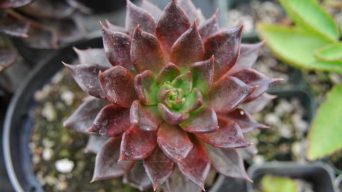
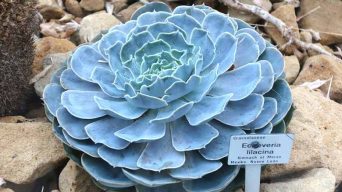

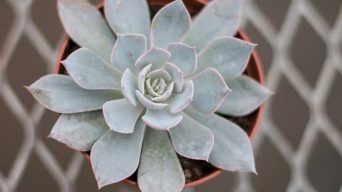
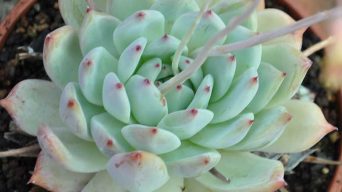
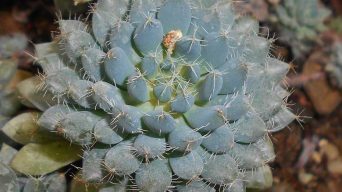
Very clear advice about this suculent.
Thanks.